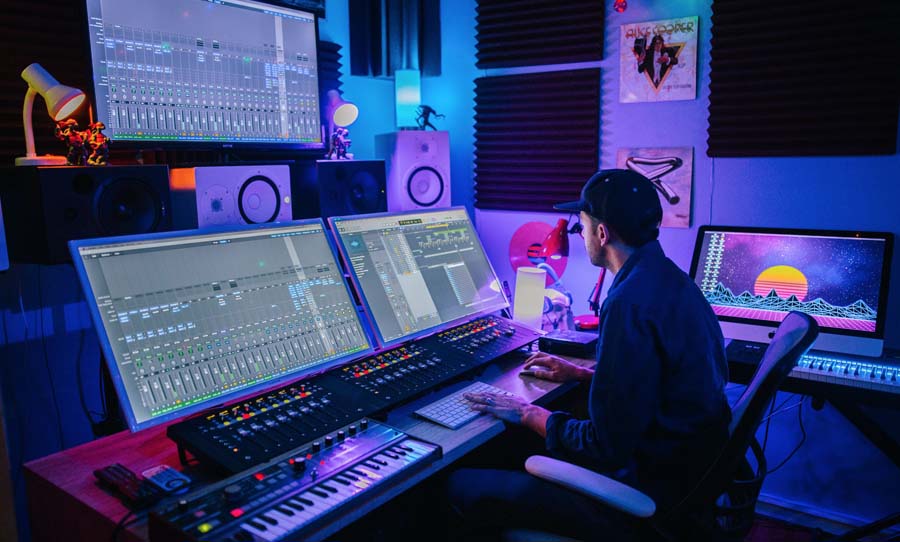It’s never been easier to make music – or so they say. Yes, the technological revolutions that have swept through the modern studio have made it easier to participate in recording and producing music. But have these giant leaps made the process more enjoyable and fulfilling?
This question is, of course, impossible to answer. The inexorable digitising of production has, however, created a multitude of options at every point in the process. We used to have blinkers on, with a vision only toward the end goal. Nowadays, the endless tweakability made possible by non-destructive methods means that we can tie ourselves in knots of stress, which we often do.
How does one find Zen in the modern studio then? Read on as we discover some tools for making sure you bring audio projects to completion and have fun along the way. 
The modern studio provides us with unprecedented choices. So how do avoid option paralysis? Check out 3 techniques for keeping your projects on track.
Eye on the Clock
There’s an old adage that goes something like this: you don’t ever finish a mix, you give up on it. At all stages in the production process, it’s hard to avoid overthinking things, chasing down the mirage of a perfect final product. And as we all know, thinking takes time.
There’s always a better take around the corner, there’s always a better setting on a plugin, there’s always an infinitesimally better syllable to use when comping a vocal. The various minutiae of a project seem to pile up higher and higher the more time you have, so even if you don’t have an official deadline, it can help to create one.
How do you create a deadline? Let me Google that for you. No, seriously, just type in the word ‘timer’ into Google and you’ve got the world’s best boss silently breathing down your neck, making anxiety-inducing, insignificant decisions melt away. Simply set a reasonable deadline and stick to it. The next time you spend a whole day tuning a single vocal take, or agonising over which kick drum sample to choose, set a timer and move onto the fun stuff.
Collaboration
Working with other people in the pursuit of art is one of life’s great joys. It’s possibly one of the biggest drivers in pursuing music in the first place. Yet, working with other people – whether they be bandmates or clients – isn’t entirely without stress.
Audio production processes can increasingly be performed remotely. This is of huge benefit, especially if your collaboration spans the globe. This new and fluid environment does, however, involve a heavy reliance on electronic communication, which can be tricky to manage.
One of the vexing problems involved in collaboration is the streamlining of communication. Imagine you’re sending a mix to a band. The bass player wants their part louder in verse 2, a few days later the guitarist chimes in with their own notes. You send the mix back – it’s approved, then the drummer returns from holiday a week later and asks you to address that drum fill leading to the bridge.
This is nobody’s idea of fun.
Tools like Filepass can help in this situation. It’s a software that collates revisions in one interface, where clients can add time-stamped comments. Ingeniously, you can even store audio files behind a paywall: no more chasing up invoices.
Musicians, like audio professionals, are increasingly aware that audio projects can be recalled eternally. If you want to find peace and put projects to bed, it pays to create clear and concise channels for communication with your collaborators.
The Limits of Control
Working primarily in the digital sphere, it’s easy to accumulate a surplus of software. When an audio processor only takes up megabytes on a hard drive, rather than real-world feet and inches in a rack or on a desk, it’s easy to indulge your hoarding tendencies. 
How many different plugins do you use though? If the leading producers of the ’60s like George Martin or Phil Spector had the hardware equivalent the plugins that routinely unfurl before us on our screens, they wouldn’t be able to see out of their control room, let alone make apt sound processing decisions.
Setting templates can help with this. In all major DAWs, you have the ability to create templates depending on what’s called for. As well as getting from point A to point B faster, it encourages you to learn the plugins you have in front of you deeply, fostering an intuitive connection between you and your gear.
Whether restricting the time that you spend on projects, creating boundaries around communication or jettisoning digital detritus from your DAW, limitation is the name of the game. The pursuit of perfection is alluring – technology has a way of making us think that it’s possible – but often, we mistakenly replace real work with busy work. Even though all the wonders of the modern studio are at our fingertips, it pays to put the blinkers back on sometimes.


